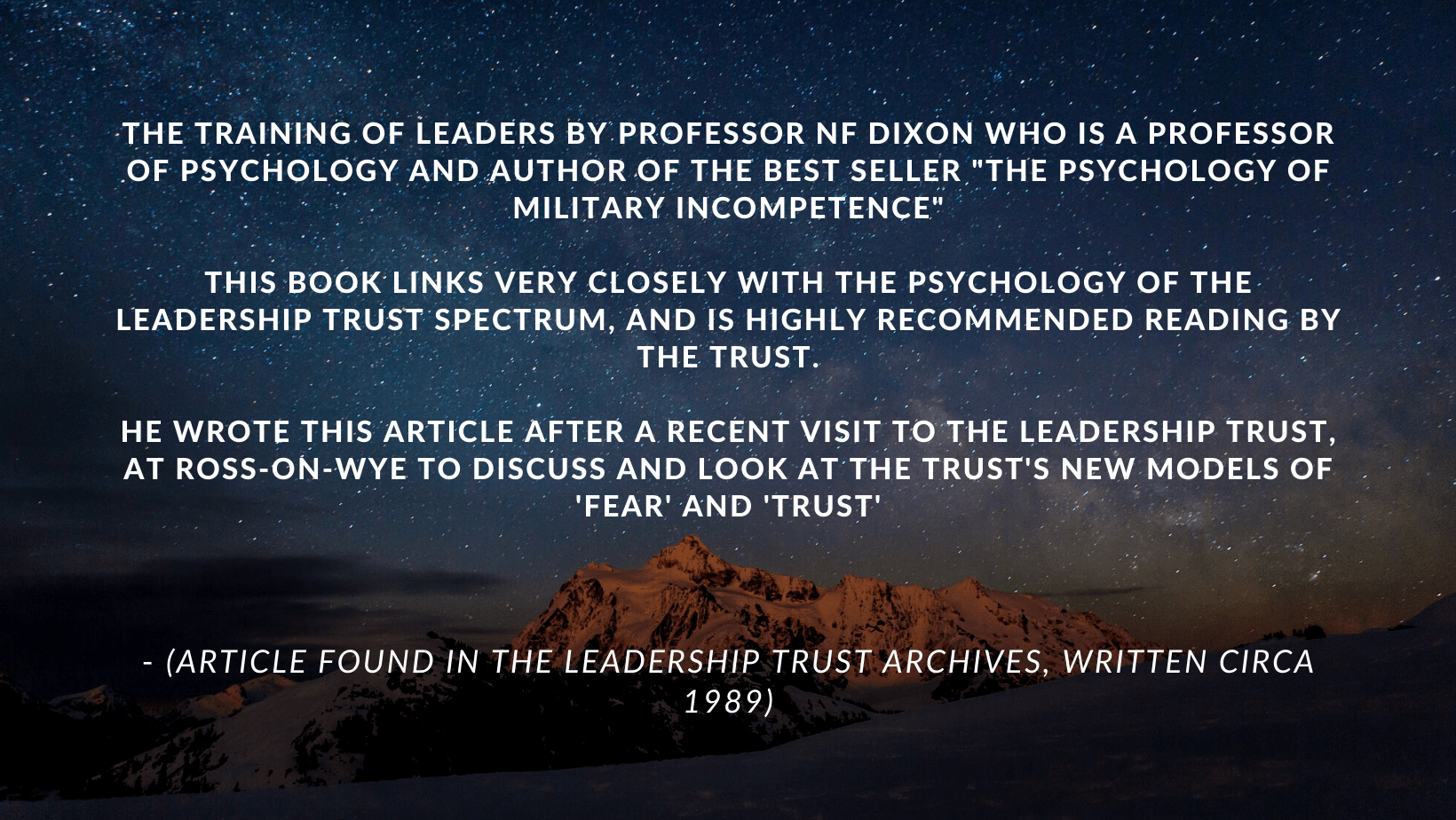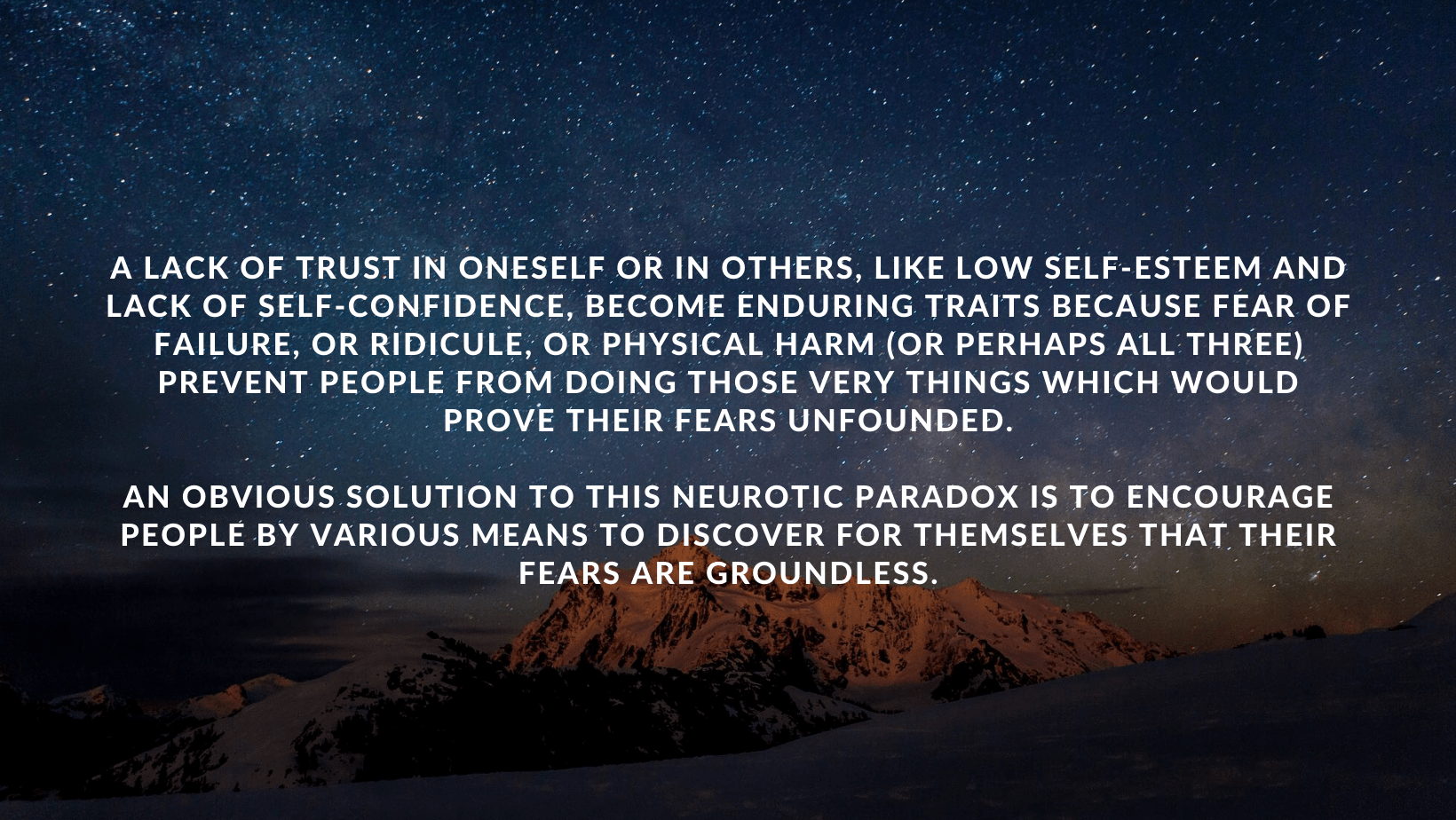

Training of leaders – Norman Dixon (circa 1989)
The so-called march of progress entailed many tasks which were beyond the mental and physical capacity of people working on their own.
Traditionally, there have been two solutions to this problem: social cooperation and technology (those ‘prosthetic’ extensions to mind and body which increase our ability to dispense information and energy).
Needless to say these aids to such enterprises as waging a war, running a business, or digging a tunnel under the sea, present problems of their own. People may resist being organised into groups for the sole purpose of carrying out tasks, in the name of goals, which are not of their choosing.
Friction may arise between members of the group. Clashes of personality, perceived or imagined inequities, jealousy, irritating habits, resentments, paranoid feelings are just some of the factors which interfere with achieving group goals.
Then again, the tasks themselves may be sources of physical and mental stress. Fatigue, pain, sickness, boredom, may, together or apart, lead to absenteeism, incompetence, accidents or sabotage.
Finally, technology itself has, paradoxically, created a new and growing hazard. The daily toll of road deaths, aircraft accidents and industrial disasters bear witness to those incompatibilities which are inherent in the man/machine interface, incompatibilities which through information overload, human error or mechanical breakdown may result in chaos on a grand scale (see Dixon 1987).
‘Teaching old dogs new tricks’
Less dramatic but more widespread is the current problem of ‘teaching old dogs new tricks’. One answer to these problems in efficient leadership, that mysterious process whereby one individual takes on the organising, directing and motivating of his fellow-men. Leadership is about getting the best out of people through example, inspiration, communication and social skills. It is about overcoming those perennial obstacles to human enterprise ignorance, apathy, and stress.
For many years the training of leaders has revolved round various sorts of physical exertion which may have nothing whatever to do with the activity the trainees will one day supervise.
Running up mountains, sliding down cliffs, shooting rapids, and trying to remain cheerful in a bivouac during winter on Dartmoor have long been favourite ways of developing qualities of leadership.
Such methods presumably derive from the days when pecking orders were decided by size and strength. For such group tasks as the dragging of enormous lumps of rock uphill or filleting a mammoth, huge, relatively brainless and unfeeling leaders were probably ideal.
Not only did they command respect, because they were the best at doing what had to be done, but they were also well equipped to discourage malingering.

Leadership Trust’s approach to training leaders
So, against this background of mindless energy it is refreshing to find that the Leadership Trust is continuing to shift the emphasis in the training of leaders from purely physical to a combination of physical and mental exercises. They do so in the knowledge that successful leadership in the modern world is a highly complex dynamic process involving such intangibles as personality, intellect, emotion and motivation.
First, in accordance with the principle conspicuously ignored by many educational establishments that the learning process is hampered by boredom and unnecessary discomfort, the Leadership Trust takes care to set the stage in such a way as to maximise the effects of what is being taught. The surroundings are sufficiently idyllic to lift the spirits of even the most reluctant delegate and living conditions compare favourably with those of any well-run hotel. In this setting the trainees have every opportunity to prepare themselves for and then benefit from exercises which, at the time, may seem designed to tax them to the limits of human endurance.
Interspersed with these challenging, sometimes threatening, and certainly not boring, tasks are a series of talks and discussions which provide a rationale for the treatment meted out.
These procedures are based on the obvious, if often overlooked, fact that the main obstacles to competent leadership lie in the domain of feelings and motivation, that, besides possessing talents for planning and direction, the competent leader must be able to handle his own feelings and, through this, those of his followers.
Directors of the Trust subscribe, quite correctly, to the view that feelings are the mainspring of human endeavour – source of great energy and creativity, that Leadership is not a matter of suppressing bad feelings, but of channelling emotions in such a way that instead of giving rise to apathy, illness, or mindless mayhem, they generate physical and mental productivity. However, to direct the emotional energies of his followers towards achieving group goals, the leader must first have come to terms with himself.
Self-awareness- the key to effective leadership
Only through self-awareness as to what makes him tick can a leader get the best out of others. These ideas and the way in which they are implemented by the Leadership Trust Courses on leadership may be summarised thus:
- Effective leadership depends first and foremost upon having positive feelings about oneself.
- It is only with self-confidence that you can be sure that what you are doing is for the best – that your planning, decision-making and way of treating others are sound.
- Self Confidence betokens an affirmative answer to the question “Would I follow myself?”. If you wouldn’t follow yourself, you could hardly expect others to do so!
- A lack of belief in oneself raises doubts in the minds of followers – “How can I believe in what he says or does when he himself seems so unsure? If he is so unsure this must mean that the situation is worse than we’ve been led to believe. He can’t be trusted to tell us the truth. Therefore I don’t trust him. Therefore I won’t follow him!”
- Low Self Esteem with its accompanying fear of failure may result in a number of neurotic tendencies that militate against effective, competent leadership. They include putting the goal of achieving social approval and popularity above all other considerations; displaying abject obedience and conformity, and a predilection for undertaking tasks that are either so easy that failure is virtually impossible, or so difficult that failure is excusable.
- Leadership, like love, is founded on trust. But the trust of others depends upon trust in oneself.

The various means include:
- Placing people in a supportive group presided over by someone they have learned to trust.
- Letting them discover through group discussion that they are not alone in experiencing fear and lack of confidence.
- Helping them to see that, far from being shameful, fear is a natural, biologically valuable emotion which can be handled and turned to good account.
- Discovering, through actually experiencing activities which they had feared, that they and fellow delegates emerge not only unscathed but ready to take on even bigger challenges.
- Consolidating the effects of what they have discovered about themselves by post hoc discussion with others who went through the same mill.
Conclusion
Taking the view that two of the most important feelings for effective leadership are fear and trust, three and a half days are devoted to experiencing the benefits of their relationship. Moral and physical courage (which would be meaningless concepts were it not for the biologically necessary emotion of fear) result from experiencing at first hand that, through inculcating mutual trust between leaders and followers, fear can be transmuted into the self-esteem that comes from successfully meeting severe challenges to body and mind.
It’s a deceptively simple formula but judging from the results so far, it appears to work. One other important reason for its success is that the Directors of the Leadership Trust, for all their progressive thinking, have not forgotten that old adage “Never ask anyone to do anything you wouldn’t do yourself!” even when this includes a leap in the dark (literally) from a very high tower.
Learn more about Leadership Trust and how
we can help you and your organisation